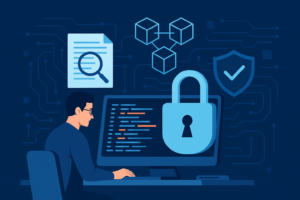As blockchain technology rapidly evolves, so does the complexity of decentralized applications (dApps), DeFi protocols, NFT platforms, and smart contract ecosystems. With billions of dollars locked in smart contracts and the proliferation of cross-chain platforms, the stakes have never been higher for ensuring security and trust. One-time audits are no longer sufficient in this fast-paced, adversarial environment. The industry is now gravitating toward continuous auditing—a security practice that provides ongoing validation and monitoring of blockchain-based codebases.

So, is continuous audit becoming the new gold standard for secure blockchain development? Let’s explore why this paradigm shift is gaining traction, how it works, its advantages over traditional audits, and what it means for developers, investors, and end-users alike.
Understanding the Traditional Audit Model
In the early days of smart contract deployment, security audits were treated as a one-time event—a final checkpoint before a project went live. Teams would develop their smart contracts, hand them off to third-party auditors, receive a report, fix critical issues, and deploy the contract. While this model worked initially, it started showing cracks as the Web3 space matured.
The static nature of traditional audits means they only capture vulnerabilities at a specific moment in time. Once the audit is complete, the code is considered “safe”—even if new features are added later, integrations change, or new vulnerabilities emerge in the broader ecosystem. This creates a false sense of security, especially in protocols that undergo frequent upgrades, token integrations, or governance proposals.
Why Static Audits Are No Longer Enough
The blockchain ecosystem is fundamentally dynamic. DeFi protocols continuously update their smart contracts. DAO treasuries evolve with new rules. NFT platforms integrate with other marketplaces and tools. Even a seemingly minor upgrade can introduce vulnerabilities.
Meanwhile, attackers are becoming more sophisticated, often exploiting unmonitored contract behaviors or reentrancy attacks that bypass initial audit coverage. The exploit of the Wormhole bridge in 2022, which resulted in a $320 million loss, is a stark reminder that even audited code can be exploited if changes are not tracked and tested continuously.
Add to this the rise of modular contracts, Layer-2 scaling solutions, and restaking protocols, and it becomes clear that blockchain codebases are no longer static, isolated units—they’re living systems. This demands a new approach: one that aligns with the iterative, interconnected nature of modern decentralized infrastructure.
What Is Continuous Audit?
Continuous auditing is a real-time, ongoing process of monitoring and evaluating the security of blockchain applications throughout their development and post-deployment lifecycles. Rather than relying on a single-point-in-time assessment, continuous audit combines automation, real-time threat detection, and regular manual review to ensure that changes to smart contracts and dApps are always under scrutiny.
It involves:
-
Automated scanning of smart contract updates using static and dynamic analysis tools.
-
Real-time alerts for unauthorized changes, on-chain anomalies, and external vulnerabilities.
-
Re-auditing triggered by governance changes, protocol upgrades, or external integrations.
-
Security dashboards for transparency across dev teams and stakeholders.
-
Integration with CI/CD pipelines so every contract push is tested before going live.
This model not only mitigates risk in real time but also helps developers maintain higher security standards throughout the product lifecycle.
How Continuous Auditing Works in Practice
Implementing a continuous audit framework typically starts by integrating smart contract code repositories with automated scanning tools. These tools monitor each code commit for known vulnerabilities such as integer overflows, reentrancy bugs, or missing access controls. Every time a new update is pushed, the system flags potential issues and sends alerts to the development team.
Additionally, many continuous audit platforms deploy runtime monitoring agents that observe smart contract behavior on-chain. If a contract begins consuming abnormal amounts of gas, interacts with unexpected wallets, or initiates unusual token transfers, the system can trigger a security response.
Protocols can also define policies for when manual audits should be retriggered—such as after major governance changes, new liquidity pools, or oracle integrations. This hybrid approach—automation plus human review—offers a layered defense mechanism, reducing the chances of critical exploits slipping through the cracks.
Benefits of Continuous Auditing for Blockchain Projects
Real-Time Security Assurance
One of the primary advantages of continuous auditing is its ability to deliver real-time insights. Unlike static audits that can become outdated quickly, continuous audits allow teams to detect and fix vulnerabilities before they’re exploited. This is crucial in DeFi protocols where millions of dollars are at risk every second.
Increased Trust Among Users and Investors
As rug pulls, hacks, and malicious exploits continue to plague the space, trust has become a precious commodity. Projects that adopt continuous audit practices signal a strong commitment to transparency and security—two pillars that resonate deeply with both retail users and institutional investors.
Having a continuous audit framework in place can also help projects meet growing regulatory demands for risk assessment, disclosure, and reporting—especially in regions like the EU or the U.S., where crypto compliance standards are evolving quickly.
Faster, Safer Innovation
With continuous audits embedded into the development lifecycle, teams can iterate faster without compromising security. CI/CD pipelines connected to audit tools ensure that every code deployment is scanned for vulnerabilities, helping developers catch issues early and reduce the cost of fixing bugs post-launch.
This enables teams to build with confidence, ship features faster, and reduce technical debt—all while maintaining robust security practices.
Improved Incident Response
Continuous audit systems often include on-chain monitoring and anomaly detection features that act like an early warning system. If an exploit begins, the protocol can be paused, or a multisig wallet can intervene before more damage is done. This proactive approach reduces the fallout from attacks and improves the protocol’s resilience.
The Role of AI and Automation in Continuous Audit
The rise of AI-driven audit tools is pushing continuous auditing even further. Machine learning models can now detect complex behavioral patterns, flag suspicious contract logic, and even predict attack vectors based on past exploit data. These intelligent systems enhance audit coverage beyond simple rule-matching.
For example, AI-powered tools can simulate edge-case scenarios in contract behavior that human auditors might miss. They can also prioritize audit findings based on exploit likelihood and potential financial impact, helping teams focus on the most pressing risks.
Platforms like OpenZeppelin Defender, Certora, Forta, and ChainSecurity are already providing frameworks for continuous analysis, AI-based testing, and decentralized security intelligence.
How Continuous Audit Enhances Smart Contract Lifecycle Management
In the Web3 space, smart contracts are no longer set-it-and-forget-it assets. They require lifecycle management—from design and testing to deployment, maintenance, and deprecation. Continuous auditing provides a backbone for this lifecycle by:
-
Monitoring deprecated functions and outdated contract versions.
-
Verifying permission updates after governance votes.
-
Ensuring compliance as the protocol evolves.
-
Maintaining a clear audit trail for future investors and partners.
This continuous layer of oversight is especially critical in projects using proxy contracts or upgradable smart contract architectures, which introduce additional layers of complexity and risk.
Use Cases: Projects Embracing Continuous Audit
Many top-tier blockchain protocols are already embracing continuous auditing to secure their ecosystems:
-
Aave and Compound integrate real-time monitoring for smart contract interactions and oracle updates.
-
Polygon and Arbitrum maintain frequent re-audits as part of their ongoing Layer-2 upgrades.
-
Uniswap uses automated audit tools to evaluate third-party plugin integrations in its open marketplace.
-
Enterprise-grade platforms working with security-focused firms like OpenZeppelin are embedding audit APIs directly into their development environments.
These real-world use cases show that continuous auditing is not just a theoretical model—it’s already delivering value at scale across high-impact projects.
Final Thoughts:
In a decentralized world where code is law, security must be more than a checkbox—it must be a mindset. Continuous auditing isn’t just a trend; it’s an evolution in how blockchain systems are built, monitored, and protected.
As DeFi protocols, NFT platforms, and cross-chain applications become more complex and interconnected, the need for 24/7 security assurance becomes non-negotiable. Continuous audit offers a scalable, real-time defense mechanism against an increasingly sophisticated threat landscape.
For Web3 startups, adopting continuous audit early can build long-term credibility. For investors, it’s a sign of maturity and risk management. For developers, it offers the peace of mind to innovate rapidly without compromising on safety.

